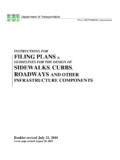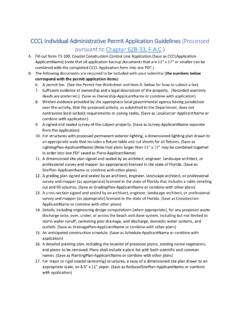Transcription of SOURCE EMISSIONS MONITORING TEST …
1 SOURCE EMISSIONS MONITORING TEST guidelines . version connecticut Department of Energy &. Environmental Protection (DEEP). Bureau of Air Management SOURCE EMISSIONS MONITORING 79 Elm St., 5th Floor Hartford, CT 06106-5127. 9/14/2017. The DEEP SEM Unit has updated and revised the SEM EMISSIONS Test guidelines as part of its'. LEAN Initiative to launch its new compliance EMISSIONS testing and Relative Accuracy Test Audit operational procedures. Section 1. Introduction _____ 2. Section 2. Clean Air Act National Stack Testing Guidance _____ 2. Section 3. Selection of the Measurement Site _____ 2. Stack Testing _____ 2. 1. Existing Sources _____ 2. 2. New or Modified Sources _____ 3.
2 Relative Accuracy Testing _____ 3. Section 4. Intent to Test (ITT) Forms (DEEP) & Performance Test Notifications (EPA) _____ 3. Standard and Non-Standard Test Protocols _____ 3. 1. Standard Test Protocols (Due 60-days in advance of proposed test date) _____ 3. 2. Non-Standard Test Protocols (Due 90-days in advance of proposed test date) _____ 3. Performance Test Notifications - EPA Region 1 _____ 5. Section 5. Performance Test Timeframes (Including Waivers and Extension) _____ 5. Section 6. Conducting the Stack Test _____ 7. Process Operating Conditions _____ 7. 1. Stack Testing _____ 7. 2. Relative Accuracy Testing _____ 7. Representative Conditions _____ 7. Test Stoppages and Postponements _____ 7.
3 1. Non-Title V SOURCE Stoppage _____ 8. 2. Major SOURCE Stoppage (Title V SOURCE ) _____ 8. 3. Postponements _____ 8. 4. Interrupted Testing _____ 8. Test Observations _____ 9. Section 7. Submittal of Test Reports _____ 9. Section 8. Test Report Contents _____ 10. Section 9. Helpful SOURCE Testing Web Links _____ 10. SEM Test guidelines 1 of 10 9/13/17. Section 1. Introduction Emission tests are performed in the State of connecticut for the purposes of (1) determining what the actual EMISSIONS of a pollutant are, (2) determining compliance with air pollution permits and regulations, and (3) for conducting Continuous EMISSIONS MONITORING (CEM) relative accuracy test audits (RATA).
4 All EMISSIONS testing must be conducted in accordance with procedures prescribed by or acceptable to the Department of Energy and Environmental Protection (hereinafter referred to as the DEEP ). These guidelines are designed to ensure standardization of test requirements, standards regarding test equipment and competence of persons intending to perform emission tests . Failure to follow these guidelines or provide the information required may result in the rejection of the test and/or test program. The SOURCE owner or operator should review all applicable permits, federal and state regulations and enforcement orders prior to completing the intent to test form and an emission test protocol.
5 Reference test and analysis methods for stack testing and CEM relative accuracy testing are as specified in Title 40, Code of Federal Regulations (CFR) 1, Parts 51, 60, 61, 63 and 75. The reference methods and equipment requirements must be strictly complied with, unless otherwise specified and agreed to by the DEEP. Intent to Test (ITT) Forms and attachments (when applicable), test protocols for non-standard test protocols, EMISSIONS test reports, and completed Compliance Certification forms and any associated correspondence should be submitted to the SOURCE EMISSIONS MONITORING (SEM) to address. Section 3 of these guidelines outline the revised ITT procedures. Section 2. Clean Air Act National Stack Testing Guidance The requirements contained in US EPA's Clean Air Act National Stack Testing Guidance are hereby incorporated by reference.
6 They are available at the following web address: Section 3. Selection of the Measurement Site Selection of the measurement site must be in accordance with Reference Method 1 of 40 CFR Part 60. Plan and elevation drawings of the duct and stack configuration must be submitted to the DEEP in accordance with the following: Stack Testing 1. Existing Sources For an existing SOURCE , drawings must be submitted with the test protocol described below showing the plan and elevation view of the ducting and stack arrangement. The drawings must include the position of all processes or operations venting to the stack or duct to be tested. It must also include the position of the sampling ports relative to the nearest upstream and downstream gas flow directional or duct dimensional change; and 1.
7 Code of Federal Regulations (eCFR). SEM Test guidelines 2 of 10 9/13/17. 2. New or Modified Sources For a new or modified SOURCE , design drawings as specified above must be submitted to the SEM. unit prior to construction (as well as with the test protocol). A representative of the SEM unit may also perform an inspection of the proposed sample port locations during the construction phase. Relative Accuracy Testing For relative accuracy testing, the measurement site must be selected in accordance with the applicable relative accuracy test procedures contained in 40 CFR 60, 61, 63 and/or 40 CFR 75 (as may be applicable). Section 4. Intent to Test (ITT) Forms (DEEP) & Performance Test Notifications (EPA).
8 The DEEP has released two new ITT Forms to separate the compliance EMISSIONS test procedures from the CEMS relative accuracy test auditing procedures: ITT Form for Compliance EMISSIONS Testing and ITT Form for CEMS Relative Accuracy Test Audit which replace the former (combined) ITT Form. Regardless of which form is submitted, the DEEP has also implemented an additional subcategory for the ITT process: Standard versus Non-Standard test protocols. Standard and Non-Standard Test Protocols ITT Forms must be received by the SEM unit within the applicable timeframe specified below, unless a more stringent requirement is specified in an applicable regulation, permit or enforcement order.
9 ITT Forms must be sent electronically to Hard copies of the ITT forms may also be submitted but must also be sent electronically. 1. Standard Test Protocols (Due 60-days in advance of proposed test date). Following are examples of test drivers that require Standard Test Protocols: a. NSR Permit for recurring testing (after an initial performance test);. b. Annual RATA after a certification RATA is performed;. c. NSPS testing recurring testing pursuant to 40 CFR Part 60 Subpart KKKK;. Standard Test Protocols require the submittal of a completed ITT Form and do not require a separate test protocol. Submittal of completed ITT Forms are due 60-days in advance of proposed test dates.
10 The DEEP will not issue formal approval letters for Standard test protocols. 2. Non-Standard Test Protocols (Due 90-days in advance of proposed test date). Non-Standard test protocols require more time to review to ensure that program requirements will be met and are required for the following test drivers but are not limited to: a. Initial performance testing;. b. Testing that proposes the use non EPA Reference Method;. SEM Test guidelines 3 of 10 9/13/17. c. All VOC sources;. d. MWC sources performing testing pursuant to RCSA Section 22a-174-38; and e. Initial Certification RATA for new CEMS or new equipment;. f. Any variance from the requirement to test at 90% of MRC. Non-Standard test protocols require additional attachments (a detailed test protocol that meets the requirements of this Section of these guidelines ).














